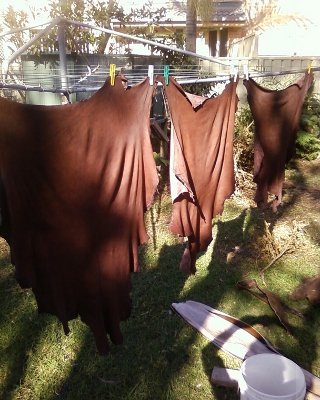
Four ways to tan hides
 Several of you have asked in the past whether we tan the hides of the deer we kill,
and I've always replied that it sounds too hard. (Plus, what
would I use the leather for?) But Olson made the process seem
fascinating, and now I wish I still had this fall's hide to practice
on! The author explained that there are four ways of tanning
hides, and each process results in a different end product.
Several of you have asked in the past whether we tan the hides of the deer we kill,
and I've always replied that it sounds too hard. (Plus, what
would I use the leather for?) But Olson made the process seem
fascinating, and now I wish I still had this fall's hide to practice
on! The author explained that there are four ways of tanning
hides, and each process results in a different end product.Rawhide is the simplest method of tanning skin. First, you remove the flesh by scraping (a process you have to use for any type of tanning). Usually, the hair is removed as well, which involves soaking the hide in water or in a mixture of wood ashes and water, then pulling out the hair. After that, a skin earmarked for rawhide is simply laced into a frame or tacked to a board to dry. Rawhide is traditionally used to make drums, kayaks, containers, roofing, or armor.
When I first eschewed tanning, I was assuming the only method was brain-tanning, which is a very common technique used to create a breathable fabric called buckskin. You first remove the skin and hair using the methods mentioned above, then you work brains (or eggs or soap and oil) into the skin. Next, comes a softening step which involves stretching the skin in many different directions, and you end by smoking the skin to make the softening permanent.
 Bark-tanning
creates a water-resistant skin, and was traditionally used to make
footware, rain slickers, leather jackets, belts, harnesses, and
containers. The method is similar to brain-tanning, but you use
tannin-rich water (bark tea) rather than brains, and you soften the skin
by working in oil.
Bark-tanning
creates a water-resistant skin, and was traditionally used to make
footware, rain slickers, leather jackets, belts, harnesses, and
containers. The method is similar to brain-tanning, but you use
tannin-rich water (bark tea) rather than brains, and you soften the skin
by working in oil.The final type of skin is a fur, which simply means you leave the hair on rather than taking it off. Olson suggests that furs work best with brain-tanning methods, so you end up with a soft, supple skin on one side and the fur on the other.
If all of these methods still sound too hard, Olson presents one final option. First, create a rawhide skin, drying it completely, then cut the skin into strips and make jello! Rehydrate the strips overnight, boil the skin-and-water mixture for four hours, add flavors, and the result will set up overnight into a tasty gelatin.
Maybe I'll try one of the simplest techniques next year. Or perhaps I'll use one of Olson's trapping suggestions to procure a small hide this winter that I can experiment on. Like other chapters in Unlearn, Rewild, this one made me want to go out and follow his lead immediately.
| This post is part of our Unlearn, Rewild lunchtime series.
Read all of the entries: |
Want more in-depth information? Browse through our books.
Or explore more posts by date or by subject.
About us: Anna Hess and Mark Hamilton spent over a decade living self-sufficiently in the mountains of Virginia before moving north to start over from scratch in the foothills of Ohio. They've experimented with permaculture, no-till gardening, trailersteading, home-based microbusinesses and much more, writing about their adventures in both blogs and books.
Want to be notified when new comments are posted on this page? Click on the RSS button after you add a comment to subscribe to the comment feed, or simply check the box beside "email replies to me" while writing your comment.
RSS
comment 1
I did about 10 deerskins to buckskins last year and it was extremely time consuming. Moisture at different stages in the tanning process can make or break your hide softness. I encourage you to try it, though, because when you make a good buckskin, it's very rewarding.
Comment by
Mandy R
— Thu Dec 26 09:52:24 2013
- Remove comment
Add a comment
